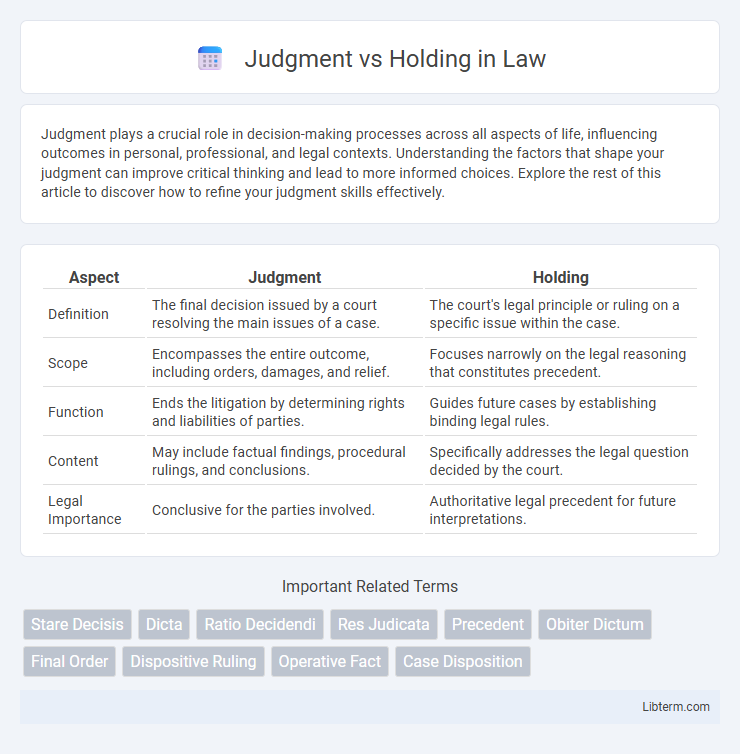Judgment plays a crucial role in decision-making processes across all aspects of life, influencing outcomes in personal, professional, and legal contexts. Understanding the factors that shape your judgment can improve critical thinking and lead to more informed choices. Explore the rest of this article to discover how to refine your judgment skills effectively.
Table of Comparison
| Aspect | Judgment | Holding |
|---|---|---|
| Definition | The final decision issued by a court resolving the main issues of a case. | The court's legal principle or ruling on a specific issue within the case. |
| Scope | Encompasses the entire outcome, including orders, damages, and relief. | Focuses narrowly on the legal reasoning that constitutes precedent. |
| Function | Ends the litigation by determining rights and liabilities of parties. | Guides future cases by establishing binding legal rules. |
| Content | May include factual findings, procedural rulings, and conclusions. | Specifically addresses the legal question decided by the court. |
| Legal Importance | Conclusive for the parties involved. | Authoritative legal precedent for future interpretations. |
Understanding Judgment: A Semantic Overview
Judgment in legal terms refers to the final decision rendered by a court resolving the issues presented in a case and determining the rights and liabilities of the parties involved. It encompasses the court's authoritative declaration on the dispute, including orders, findings, and conclusions based on the evidence and applicable law. Understanding judgment is crucial for interpreting the enforceability and scope of court rulings, distinguishing it from holdings which are specific legal principles derived from the judgment.
Defining Holding: Legal and Practical Contexts
A holding is a definitive legal determination made by a court that resolves the core issue in a case, establishing a binding precedent for future disputes. It differs from a judgment by specifically addressing the legal principle applied to the facts rather than the overall court decision. Understanding holdings is essential for interpreting case law and predicting how courts may rule on analogous issues.
Judgment vs. Holding: Key Differences Explained
Judgment refers to the final decision rendered by a court resolving the parties' disputes, while holding is the specific legal principle or rule derived from the court's analysis that directly supports that decision. A judgment concludes the case outcome, such as awarding damages or dismissing claims, whereas the holding serves as precedent for future cases by interpreting the applicable law. Understanding the distinction between judgment and holding is essential for legal professionals analyzing case law and its binding authority.
The Role of Judgment in Legal Decisions
Judgment in legal decisions represents the final determination made by a court regarding the rights and liabilities of the parties involved, dictating the enforceable outcome of the case. It encompasses the court's authoritative pronouncement that concludes the litigation, whereas the holding refers specifically to the legal principle derived from the court's reasoning that guides future cases. The judgment's role is critical as it not only resolves the dispute presented but also establishes the binding context in which the holding operates within the judicial system.
The Significance of Holding in Case Law Analysis
Holding in case law analysis signifies the court's definitive legal ruling on the central issue, establishing a binding precedent for similar cases. Unlike mere judgment, which is the court's final decision regarding the parties, the holding identifies the precise legal principle derived from the facts and applied law. This distinction is critical because holdings form the authoritative basis for future judicial interpretations and legal reasoning.
Impact of Judgments on Legal Precedent
Judgments directly influence legal precedent by establishing the official decision of a court that binds lower courts and guides future rulings. Holdings within those judgments clarify the legal principles applied, forming the core authoritative rule essential for case law development. The impact of judgments on precedent ensures consistency and predictability in judicial decisions across similar cases.
How Holdings Shape Future Legal Interpretation
Holdings establish the legal principles derived from court decisions, serving as binding precedents that guide future case law interpretation. By clarifying the application of statutes and constitutional provisions, holdings influence how judges analyze similar fact patterns and legal questions. This creates a structured framework for consistent judicial reasoning, ensuring predictable and coherent development of the law over time.
Common Misconceptions about Judgment and Holding
A common misconception about judgment and holding is that they are interchangeable legal terms, but a judgment is the final decision issued by the court resolving the dispute, while a holding is the court's specific legal principle or rule derived from that decision. Many mistakenly believe the holding includes all parts of a judgment, but it only refers to the binding legal rationale essential to the case outcome. Understanding this distinction is crucial for legal analysis and precedent application in case law research.
Practical Examples: Judgment vs. Holding in Court Cases
In court cases, a judgment refers to the final decision issued by the judge that resolves the dispute and determines the rights and obligations of the parties involved, such as awarding damages or dismissing a claim. A holding is the specific legal principle or rule derived from the court's analysis that directly addresses the issue before the court, exemplified by the Supreme Court's holding in Brown v. Board of Education, which declared racial segregation in public schools unconstitutional. Understanding the distinction helps legal professionals apply precedent correctly, distinguishing the binding legal rule (holding) from the overall outcome (judgment) in cases like Roe v. Wade or Miranda v. Arizona.
Implications for Legal Writing and Research
Understanding the distinction between judgment and holding is crucial for precise legal writing and research, as judgment refers to the court's final decision while holding denotes the legal principle derived from that decision. Accurately identifying the holding ensures that legal arguments are based on binding precedent rather than broader or non-binding statements within the judgment. This clarity enhances the persuasiveness and reliability of legal analysis, guiding effective case law interpretation and application.
Judgment Infographic

 libterm.com
libterm.com